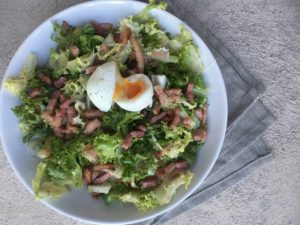
Now that I’m back in the U.S., I’ve had a number of people ask me: “How was Lyon? I’ve never been there.”


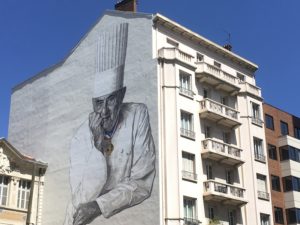
Yeah, well, you’re not alone. When Americans plan trips to France, Lyon often gets lost–jettisoned in favor of the Paris + Provence or Nice + maybe-some-Normandy-beaches loop.

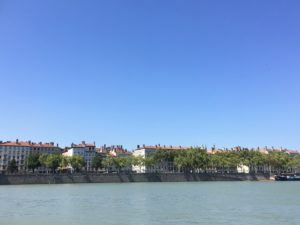
This is not a new problem for Lyon, which, despite being the third most populous city in France, has long played second fiddle to everything Parisian. Example: in 1887, construction on the Eiffel Tower began in Paris; and lo, in 1892, construction began on the Tour Métallique de Fourvière in Lyon–a structure that looks strikingly similar to the Eiffel Tower, but just isn’t, you know, the actual Eiffel Tower.


And look: I’m not here to argue that, on your first (or even second) trip to France, you should visit Lyon instead of Paris.
But taken on its own merits, Lyon has a bit to recommend it. Two rivers flow through the city, creating four quais, on which dozens and dozens of buvettes–casual outdoor bars–do a brisk business. The southeast bank of the Rhône River has been developed with fig trees, bike paths, sunbathing chairs, volleyball courts, and a children’s playground. The center of town is picturesque–with red roofs replacing the grey roofs of Paris–without ever being crowded. It has some amazing Roman and early Christian ruins.

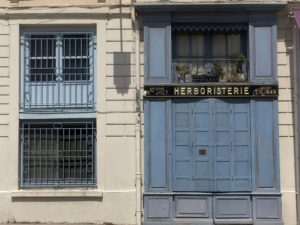
Lyon is also a great example of the diversity of France’s regional centers. In America, the whole eastern corridor looks, if not exactly alike, at least pretty similar. And the food: New Yorkers can claim better bagels and Bostonians better chowder, but one can still find plenty of good bagels in Boston and chowder in New York.


In France, this is very much not the case. I hopped on the train in Avignon, where the food specialties include goat’s cheese, salade niçoise, ratatouille, and anything with tomatoes. An hour and a half later, I got off the train in Lyon, where the specialties include the pungent, oozing St. Marcellin cheese; andouillette (a sausage made from pork intestines); and gras-double (tripe cooked with parsley and onions). Whereas Provençale cuisine focuses on vegetables and olive oil, Lyonnaise cuisine focuses on turning improbable meat parts into homey, hearty masterpieces.


In this city, it makes sense that the specialty salad–creatively called the salade lyonnaise–gets its flavor from a dressing of bacon, bacon fat, vinegar, and dijon mustard. Because Lyon isn’t happy to let you go without at least two animal products per meal, one adds a poached or soft boiled egg on top, to break over the salad at the table. Croutons add crunch. The bitter lettuce, with its serious bite, lends contrast to the rich bacon and egg. It’s a marvelous dish.
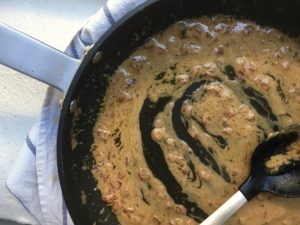
This is a great salad for dinner-type salad. Serve with wine, and add some cheese + sweet grapes or chutney for dessert, and you have a lovely meal for two.

Other recipes from a summer in France:
Salade Niçoise, My Way or Yours + A Taste of Provence
Goat Cheese Toasts with Herbed Cherry Tomato Compote
Plum Clafoutis
Ratatouille
Salade Lyonnaise
Serves two
Ingredients
1/2 to 2/3 head of frisée or other sturdy, bitter lettuce*–enough to fill two dinner plates
2 eggs
4 slices of bacon, chopped
1 shallot (or one half of a small red onion), diced
1/4 cup red wine or sherry vinegar, divided
1-1.5 tablespoons Dijon mustard
1-2 tablespoons olive oil, as needed
Freshly ground black pepper, to serve
*Whatever lettuce you choose has to be bitter, otherwise it won’t offset the richness of the bacon, and it has to be sturdy, because otherwise the lettuce will wilt under the warm dressing.
Instructions
Wash the lettuce, pat dry, and tear into salad-sized pieces. Place into a salad bowl.
Bring a pot of water to a simmer. Either poach your egg, or, if you, like me, are terrible at poaching eggs, place the eggs gently in the pot, cover, and set a timer for six minutes. When the timer goes off, remove the eggs and plunge them into cold water. When cool enough to handle, peel the eggs and set them aside.
While the eggs are cooking, add the chopped bacon to a frying pan over medium heat. Cook slowly until crisp, but not burnt. About two minutes before the bacon is done, add the shallot to the pan and continue to cook. When the bacon is lightly crispy and the shallot is soft, remove the pan from the heat. Deglaze the pan with half of the vinegar, using a spatula to scrape any browned bits of bacon and shallot from the bottom of the pan. Add the Dijon mustard. Add the rest of the vinegar.
Here’s where you need to cook au pif–to taste as you go and see if you’ve got it how you like it. Start by tasting the dressing as is. If your bacon was quite greasy, you might not need to add any olive oil at all. If the dressing is quite vinegar-y, or if there doesn’t seem to be enough dressing for two salads, add the olive oil a few teaspoons at a time. Taste again. Does it need more Dijon? More vinegar? You decide. My exact proportions are different every. single. time. I make this, but the end goal is the same: a sharp vinaigrette balanced out by the bacon fat.
When you have the dressing + bacon mixture the way you like it, pour it out of the pan into the frisée lettuce in the bowl. Toss quickly, then divide between two plates. Place an egg on top of each salad. Season with cracked pepper, if you like. Serve and enjoy!
Notes
Croutons are standard on this, but I usually can’t be bothered–though when someone else makes them, I’m all in. Baguette on the side, however, I never skip: how else are you going to sop up the bacon and eggs?
Leave a Reply